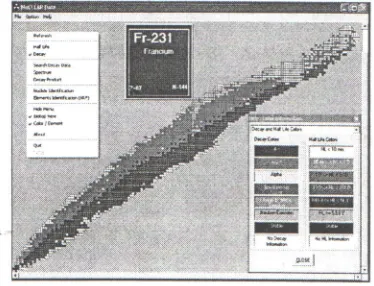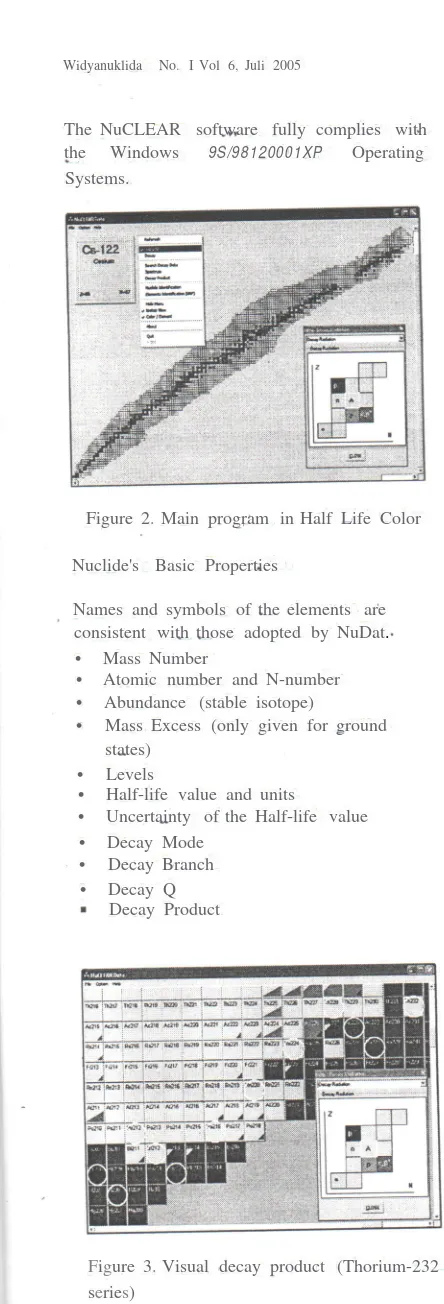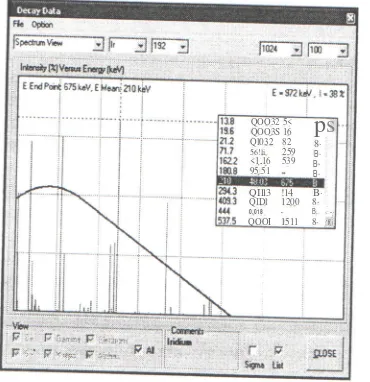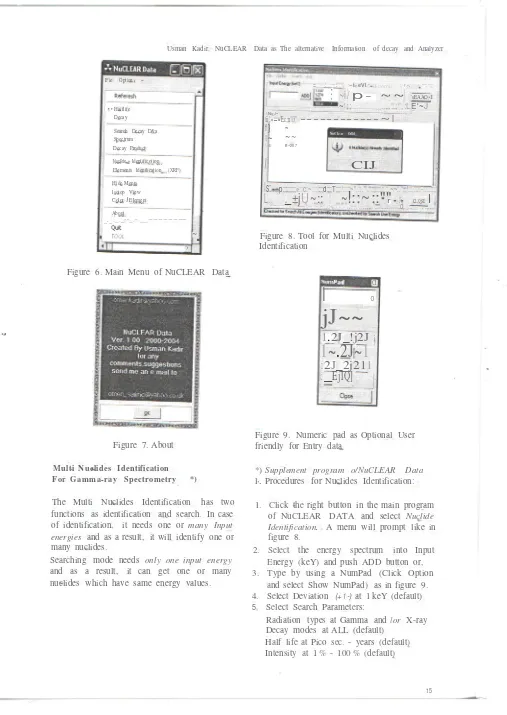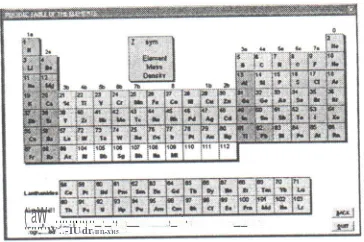NuCLEAR Data as The Alternative Information
of Decay and Analyzer
Usman Kadir
Pusat Pendidikan dan Pelatihan BA TAN Abstract
NuCLEAR Data is the name of visual, color-coded computer program of "Chart of Nuclides" or "Segre Chart". The program gives you comprehensive nuclear decay data that include data on alpha, beta, gamma, x-ray decay etc., and comprehensive search by energy, intensity, half life, radiation type or name of nuclide. NuCLEAR Data is able to show visual decay product and couldfunction as Multi Nuclides Identification and Multi Elements Identification Analysis. It is constructed using Visual Basic Compiler.
Abstak
NuCLEAR Data adalah nama program komputer untuk peta nuklida atau Segre Chart; data tervisual dan dikodekan warna. Program ini memberikan anda data peluruhan nuklir secara komprehensif, yang meliputi peluruhan alpha, beta, gamma, sinar-x dan dapat mencari energi, intensitas, waktu paro, jenis radiasi dan nama nuklida. NuCLEAR Data dapat menampilkan produk peluruhan secara visual dan dapat berfungsi sebagai analisis untuk Identifikasi multi
nuklida dan identifikasi unsur-unsur. Program ini dibuat dengan Visual Basic.
Chart of the Nuclides
Chart of the Nuclides is a plot of all known nuclides as a function of Z (Atomic number), in the y-axis, and N (number of neutrons), in the x-axis.
Figure I. Main program in Decay color
Introduction to NuCLEAR DATA
This program will provide you with visual information and reliable data on 109 elements and their isotopes.
The "Chart of the Nuclides" or Segre Chart is shown in a colored mode, including details for each nuclide's meta-stable states.
NuCLEAR for Windows 95/98/2000IXP is a visual Nuclear Data Library. It can be used as a standalone information system.
NuCLEAR uses the well-known nuclear data files NuDat as its source database file. Nuclear data on:
•
Basic Nuclide properties Decay radiationare available for each isotope. •
NuCLEAR data source contains the following information:
•
4,750 records on Nuclide's Basic properties145,888 records on Decay radiation Elements with an atomic number from 109 and isotopes from I- 266
100 records on X-ray emission energies of elements for K~I, K~2, Kal, Ka2, Lyl, Lal, La2, L~I, L~2 and Mal, M~2. •
•
All menu commands can be prompted using a right click on the mouse, and keystrokes to enhance the operation of the software like shown in figure 7.
Widyanuklida No. I Vol 6,Juli 2005
The NuCLEAR software fully complies with
the Windows 9S/98120001XP Operating
Systems.
Figure 2. Main program in Half Life Color
Nuclide's Basic Properties
Names and symbols of the elements are consistent with those adopted by NuDat. • Mass Number
• Atomic number and N-number • Abundance (stable isotope)
• Mass Excess (only given for ground states)
• Levels
• Half-life value and units
• Uncertainty of the Half-life value • Decay Mode
• Decay Branch
• Decay Q
Decay Product
Figure 3.Visual decay product (Thorium-232 series)
Mass Number,
Mass Number indicates the number of nucleons as the sum of number of protons (Z) and number of neutrons (N).
Atomic or Z-Number:
Z-Number shows the number of protons in the nuclide, which is also referred as the Atomic Number
Abundance:
It indicates the natural isotopic abundance; it is given in % unit. Abundance is only available in naturally occurring isotopes.
Mass Excess:
Mass Excess is calculated as M - A and expressed in MeV on the unified mass scale (Mass Excess of C-12=O)
LeveL:
Refers to the levels for which decay and basic properties are given. It can be indicated by "G" for ground or a value for the energy level width (in MeV) of the isomeric state.
Units of Half-life:
It is a time unit m which the half-life is expressed in pico seconds, nano second, micro seconds, milli seconds, seconds, and minutes, hours, days, and years. Stable nuclides are marked as STABLE.
Decay Modes:
Decay modes show the type of nuclide's radioactive decay. B- for Beta- decay or negatron emission, B+ for Beta+ decay or positron emission, EC for electron capture, IT for Isomeric transition, A for alpha decay or alpha particle emission, SF for Spontaneous fission, n or p for neutron or proton emission. In addition to that, there might be rare cases of decays emitting nuclides; they are denoted by the symbol of the nuclide emitted. E.g.
Decay Branch:
Decay Branch indicates relative emISSIOn probability of that type of decay from a level populating a specific product (daughter) nuclide's level. It is presented in %. When there are no competing decays, 100% is assigned to the primary decay mode. In the case of delayed emission particles (ECP, ECA, B-N, B-P, etc.) 100% is assigned to the main decay (that is to EC), while the second value represents the probability of emission of a delayed particle after a 100% occurrence of that main decay.
Example: A zero value in this field means there are no measurements or reporting values.
DecayQ:
Decay energy for the corresponding decay mode, or particle separation energy in the case of particle emissions. It is presented in MeV. Zero indicates that this information is not available.
Decay Product:
Decay Product is the resulting nuclide after a certain decay scheme or mode. It is also referred as daughter nuclide. In the case of delayed decay emission, the first decay product is shown. In the case of multiple decay emissions, the primary decay product is shown. When the decay product is not available, "N /A " will be shown (e.g. SF). We can see the visual of decay product in figure-3, simply by using the left click mouse button on the chart.
OeCOVData
Figure 4. List of decay data after click on the Main Program
QOO32 5< QOO3S 16 Ql032 82
56!li 259 <1.16 539 95.51
p
s
8·
B· B· B·
QIll3 !l4 B·
QIDl 1200 8·
0.018 - B. ¢:
-QOOI 1511 8·i'f(i
Figure 5. Spectrum view of decay data after click on the Main Program, continuous is Beta spectrum at end-point 675 keY and average value 210 keY.
Decay Radiations Data Types
Under this part of the database, nuclide's data related to its decay are stored using the following records:
• Type of Radiation • Half-life value and units. • Radiation Energy
Uncertainty for the Radiation Energy in keY.
• Intensity
• Intensity's Uncertainty in %. • Dose
• Comments
• End-point Energy, for beta type of radiations
Radioactive decays have a specific signature on the type of their particles or energy emission. In NuCLEAR we have divided the radiation types as follows:
B- positron emission B+ negatron emission G gamma-ray emission e- orbital electron emission X X-ray emission
Widyanuklida No. I Vol 6, Juli 2005
Although several of them are of the same nature, we decided to differentiate for a clearer representation.
Example: Gamma and X rays are photons, so in principle they can be symbolized as a "photon-emission", but the clear differentiation between them emphasizes the different nature of their emission process: nuclear and usually as a result of an Isomeric Transition for gammas and atomic emission, and as a result ofbeta/EC decay for X rays.
The same applies for electrons and negatrons (B-) particles. The first as a result of atomic interactions and re-organization, and the latter pure nuclear
Also this type of distribution is internationally accepted and used.
Often more information on the specific type of radiation is also given under the Comments field.
Decay Radiation Energy:
It shows energy in ke V that characterizes particular radioactive emission. In the case of beta radiation, the median energy of the spectrum is given. Radiation energies are in the Laboratory System.
Uncertainty for Decay Radiation Energy: Uncertainty of the radioactive emission energy. It is expressed in ke V.
Intensity:
Intensity is frequency of occurrence of radiation energy per 100 decays. Expressed in % unit, shown here as y-axis in figure 5.
. .~.' Intensity's Uncertainty:
It represents uncertainty of the Radiation Intensity, and expressed in% .
Dose:
Constant of Dose for emitted average energy (in equilibrium) per nuclear transformation,
expressed in grams Rad per microCurie per hour.
14
Comments:
More specific information about the nature and the type of radiation is given in the comments. Although the comments are self-explanatory, some examples and their meanings are given here:
Gamma AN XK
XKA2 EAUK
annihilation gamma ray. X rays from the K-shell. K-alpha2 X-rays.
Auger electron from the K-shell.
Conversion electron from the L-shell.
ECEL
End-point Energy:
Since the beta emission energy spectrum is continuous, the end-point energy value is given (in keY) for this type radiation. View of spectrum of Beta emission shown in figure 5.
All value of the decay radiation data shown in a list like figure 4.
Keyboard Shortcuts
The following keyboard shortcuts are built into NuCLEAR Data:
Ctrl+I Zoom into the graphical
representation of the Chart of the Nuclides or (+) num. pad
Ctrl+O Zoom out from the graphical representation of the Chart of the Nuclides or (-) at Numeric pad Ctrl+D Sets the view mode to Decay. Ctrl+H Sets the view mode to Half-life. Ctrl+C Copy the selected text to the Clipboard.
Fie Option ~
Decay
i• •Haiflife
Search DecayD&a Spectrum Decay Product
Nuc6de ldentificotion Elements ldentlication (XRF) Hide Menu
lsotop View ColorIElement
About
)_._.._._--_.-..
_---~
.
.')
Figure 6. Main Menu of NuCLEAR Data
..
Figure 7.About
M ulti Nuclides Identification
For Gamma-ray Spectrometry *)
The Multi Nuclides Identification has two functions as identification and search. In case of identification, it needs one or many Input energies and as a result, it will identify one or many nuclides.
Searching mode needs only one input energy and as a result, it can get one or many
nuclides which have same energy values.
=___:___:""";:~t>eVI.".,.,,,,,,,,,,, r-. "'''''';
~i/
p - ~~ 'sEAAO<I ~';; ....,...."..;",:LE'~Jf.No.l~ .. ~
fii',.=---='E;c.;n'13"---~l
f} ~
[~ ~~
I.G. B~207
I
CIJ
;
I
s
:
...,
p;;;;;;;~::c:~::;:;;d;;;T;;:'::::~",:,."'.":::;:.:.:.~~;.";:'::,::::-::::::;'L
,,
,
_
±j
U
~
::
~
!::
~
::""
r• •Ji C1.QSEI
'''' "··,"""",,,·,,"''''''',,·.. ,,',,.,,,..,,..,,'', ,,..,,,,,,,,,..d, .., ",..,..,,"NuClc<u Odld ~
Figure 8.Tool for Multi Nuclides Identification
'.. Cl
I
0j
J
~~
1
.
2
J
_
!
j
2
J
i1
~
.
2
J~
1
:
2
J
_
2
j
2
1
1
;
__
E
j
1
Q
]
.
Figure 9. Numeric pad as Optional User friendly forEntry data
*)Supplement program o/NuCLEAR Data 1. Procedures for Nuclides Identification:
1. Click theright button in the main program of NuCLEAR DATA and select Nuclide Identification. A menu will prompt like in
figure 8.
2. Select the energy spectrum into Input
Energy (keY) and push ADD button or,
3. Type by using a NumPad (Click Option
and select Show NumPad) as in figure 9.
4. Select Deviation (+1-)at 1 keY (default)
5, Select Search Parameters:
Radiation types at Gamma andlor X-ray
Decay modes at ALL (default) Half life at Pico sec. - years (default)
Widyanuklida No. I Vol 6,Juli 2005
6. Set Identification to Checked 7. Finally, push SEARCH button
8. During process, SEARCH button have a
function CANCEL process
For example:
Select the input energy 661,1173, 1332,
1274,569 and 1064 in keY. Note: do not enter energy 511 keY
The results are Cs-137, Ba-137, Co-60,
Na-22, Pb-207, Bi-207
II. Procedure for Search Nuclides by Energy:
1. Click the right button in the main program
NuCLEAR DATA and select Nuclide
Identification and a menu will prompt like
in figure 8.
2. Select the energy spectrum into Input
Energy (keY) and push ADD button or,
.3. Type by using a NumPad (Click Option
and select Show NumPad) like figure 9.
4. Select deviation (+1-) at 1 keY (default)
5. Select Search Parameters, such as:
Select Radiation types
Decay modes at ALL (default)
Halflife at Pico sec.- years (default)
Intensity at 1 % - 100 % (default)
6. SetIdentification Check to Un-Checked
7. Click one of all energies in the list of
input energies (make a highlight)
8. Finally, push SEARCH button
9. During the process, Search button have a
function to CANCEL the process
From the list of result, we can see detail
information of nuclide by using double click
mouse on the list.
Multi Elements Identification
For X-ray Fluorescence *)
(
'a
W"'...
.
.
.,.._
.
_
.
, __
,
_~
.
__
"""'W..-IUdr,III1-X1l5
Figure 10. Periodical Table of The elements as the main appearance
Figure II.Spectrum Yiew after click on
Periodical Table
i
X::7-
:
:
~~
~~·~
;'
~
'
f
:·
I
:.~--·
·
-
-··-
-
···
1M';?: ....
,-= = -
Deer""~fner'1fON
Figure 12. X -ray emission Energies versus
TheElements
Procedures for Elements Identification:
1. Click the right button in the main program
NuCLEAR OAT A and select Elements
2. Now, Periodical Table is the main appearance like in figure 10. (NuCLEAR DATA disappear)
3. Click the right button and select Element(s) Identification by Chart (figure 12)
4. Click the right button while cursor on the Chart and select Input energy ON
5. Select Energy spectrum into Input Energy (keV) and push ADD button or,
6. Type by using a Numeric Pad (Click Num Check) and push Enter
7. Set Refresh Data button to Checked 8. Finally, Sum of Elements at Combo menu
shown number of elements prediction
For example:
Select the input energy 22.982, 23.172, 26.093, 26.641, 72.794, 74.957, 84.922, 87.343,81.08,83.8,94.'677 and 97.616
The Instant results are 48 Cd, 82 Pb, 86 Rn and Number of elements prediction are 3.
If necessary, display spectrum view by clicking the right button in the main program and select X-ray emission energies chart, like in figure 11
After you got the result, check all the data must a cross curve by using Z-Cursor combo menu on the left-bottom or move mouse on the Periodical-Table.
If necessary, show zoom window by clicking the right button on the Chart and select zoom /'
Lock the result by using Trace Element Lock
at the main program, and to free it use Trace Element Unlock.
Erase all data, delete item in the input energy, shift up and shift down by clicking right mouse on the list of input energy.
Widyanuklida No. I Vol 6, Juli 2005
References:
1. Nuclear Data (NuDat) files were first created and are maintained by Brookhaven National
Laboratory (BNL) - National Nuclear Data Center, USA.NuDat files were extracted from ENSDF (Evaluated Nuclear Structure Data Files). NuDat and ENSDF are available from and are maintained by major Nuclear Data Centers. For further inquires on NUDAT, contact the National Nuclear Data Center, Brookhaven National Laboratory ,USA.
I
2. Microsoft Visual Basic Compiler, Computer Program, Microsoft
3. NuChart, Computer Program, Canberra
4. Nuclide Navigator II, Computer Program, EG&G ORTEG
5. Nicholas Tsoulfanidis, Measurement and Detection of Radiation, Hemisphere publishing
Corporation, 1983
6. Grafton D. Chase & Joseph L. Rabinowitz, Principles Radioisotop Methodology, Burgess
Publishing Company, 1967
7. Hiroshi Tominaga, Rapid Determination of Multi-Elements in Thin Specimen by X-Ray
Spectrometry, Nuclear Instruments And Methodes - North-Holland Publishing Co., 1974
8. Takao Tojo, Introduction to Ge Gamma-ray Spectrometry, BATAN-JAERI Training Course,
Jakarta - Indonesia, 1997
9. Alonso & Finn, Quantum & Statistical Physiscs III,Addison Wesley, 1982
10. Masayasu NOGUCHI, Gamma-ray Spectrometry with a Ge Detector, Instructor Training
Program JAERI for BATAN - NuTech JAERI, 2004
11. SEIKO EG &G, X-ray Critical Absorption and Emission Energies Chart, Instruction manual
12.Radioisotope Pocket Data Book, Japan Radioisotope Association, Tokyo -Japan.
